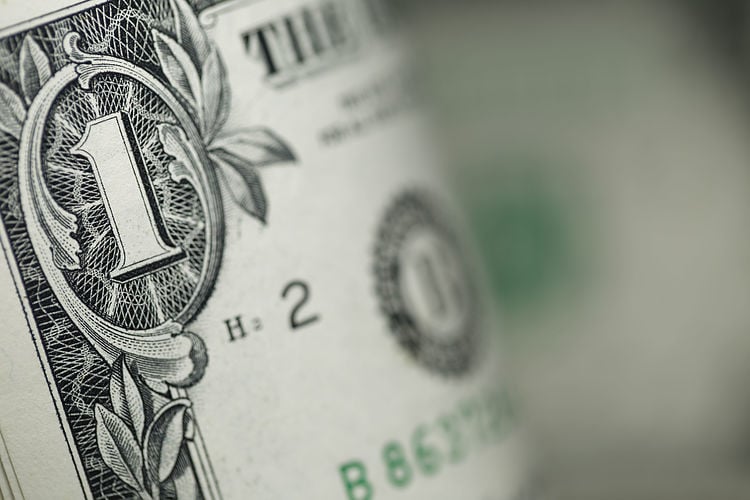Traders are diving into the Greenback on Fed’s Waller hawkish tilt.
The US Dollar Index jumps to a new high for March.
The US Dollar (USD) retreats from its earlier fresh highs for March after the Greenback rallied on comments from Fed Board Member Christopher Waller who pulled the plug on a June interest-rate cut. The Greenback is rolling through the markets and is up against every major G20 peer. Markets are heading into the direction of fewer and later rate cuts while the economy and inflation flair up.
The very packed economic calendar for this Thursday is leaving its marks with the Continuing claims contradicting the upbeat US Gross Domestic Product print. This makes traders nervous with data points diverging and not painting a clear picture. More data to come with the Unversity of Michigan numbers and Purchase Managers Index from Chicago.
The first batch of data has been released:
The US Gross Domestic Product final reading for Q4:
Headline GDP went from 3.2% to 3.4%.
The GDP Price Index remained unchanged at 1.7%.
Core Personal Consumption Expenditures retreated a touch from 2.1% to 2%.
This week’s Jobless Claims:
Initial Claims remained stable at 211,000.
Continuing Claims jumped higher to 1.819 million, coming from 1.795 million.
The Chicago Purchasing Manager Index for March is expected to head from 44 to 46 at 13:45 GMT.
At 14:00 GMT, the final reading for the University of Michigan for March will come out:
Consumer Sentiment is expected to remain unchanged at 76.5.
Consumer Inflation expectations will remain stable as well at 2.9%.
The Kansas Fed Manufacturing Index for March will be released at 15:00 GMT, and was previously at 3. No forecast is available.
US equities are trading flat still in the aftermath of the US GDP and Jobless claims print.
According to the CME Group’s FedWatch Tool, expectations for the Fed’s May 1 meeting are at 94.8% for keeping the fed funds rate unchanged, while chances of a rate cut are at 5.2%.
The benchmark 10-year US Treasury Note trades around 4.21%, up from 4.18% earlier this week.
The US Dollar Index (DXY) got fired up by Fed’s Waller overnight after the official pushed back against June rate cut expectations and obliterated any hopes for cuts from the US Federal Reserve before the summer. US Dollar bulls chased the DXY higher on the back of it, which results in a fresh high for March and the February highs are coming into reach now. Should the Personal Consumption Expenditures (PCE) Price Index bear a red hot inflation label again, expect for the DXY to quickly reach 105.00 and higher.
That first pivotal level for the DXY at 104.60 has been broken, where last week’s rally peaked. Further up, 104.96 remains the level to beat in order to tackle 105.00. Once above there, 105.12 is the last resistance point for now before the Relative Strength Index (RSI) will trade in overbought levels.
Support from the 200-day Simple Moving Average (SMA) at 103.75, the 100-day SMA at 103.48, and the 55-day SMA at 103.72 are unable to show their importance as support because traders didn’t wait for a drop to those levels for a turnaround. The 103.00 big figure looks to remain unchallenged for longer, after the decline in the wake of the Fed meeting last week got turned around way before reaching it.
Interest rates are charged by financial institutions on loans to borrowers and are paid as interest to savers and depositors. They are influenced by base lending rates, which are set by central banks in response to changes in the economy. Central banks normally have a mandate to ensure price stability, which in most cases means targeting a core inflation rate of around 2%. If inflation falls below target the central bank may cut base lending rates, with a view to stimulating lending and boosting the economy. If inflation rises substantially above 2% it normally results in the central bank raising base lending rates in an attempt to lower inflation.
Higher interest rates generally help strengthen a country’s currency as they make it a more attractive place for global investors to park their money.
Higher interest rates overall weigh on the price of Gold because they increase the opportunity cost of holding Gold instead of investing in an interest-bearing asset or placing cash in the bank. If interest rates are high that usually pushes up the price of the US Dollar (USD), and since Gold is priced in Dollars, this has the effect of lowering the price of Gold.
The Fed funds rate is the overnight rate at which US banks lend to each other. It is the oft-quoted headline rate set by the Federal Reserve at its FOMC meetings. It is set as a range, for example 4.75%-5.00%, though the upper limit (in that case 5.00%) is the quoted figure. Market expectations for future Fed funds rate are tracked by the CME FedWatch tool, which shapes how many financial markets behave in anticipation of future Federal Reserve monetary policy decisions.
Share:
Feed news
Information on these pages contains forward-looking statements that involve risks and uncertainties. Markets and instruments profiled on this page are for informational purposes only and should not in any way come across as a recommendation to buy or sell in these assets. You should do your own thorough research before making any investment decisions. FXStreet does not in any way guarantee that this information is free from mistakes, errors, or material misstatements. It also does not guarantee that this information is of a timely nature. Investing in Open Markets involves a great deal of risk, including the loss of all or a portion of your investment, as well as emotional distress. All risks, losses and costs associated with investing, including total loss of principal, are your responsibility. The views and opinions expressed in this article are those of the authors and do not necessarily reflect the official policy or position of FXStreet nor its advertisers. The author will not be held responsible for information that is found at the end of links posted on this page.
If not otherwise explicitly mentioned in the body of the article, at the time of writing, the author has no position in any stock mentioned in this article and no business relationship with any company mentioned. The author has not received compensation for writing this article, other than from FXStreet.
FXStreet and the author do not provide personalized recommendations. The author makes no representations as to the accuracy, completeness, or suitability of this information. FXStreet and the author will not be liable for any errors, omissions or any losses, injuries or damages arising from this information and its display or use. Errors and omissions excepted.
The author and FXStreet are not registered investment advisors and nothing in this article is intended to be investment advice.





